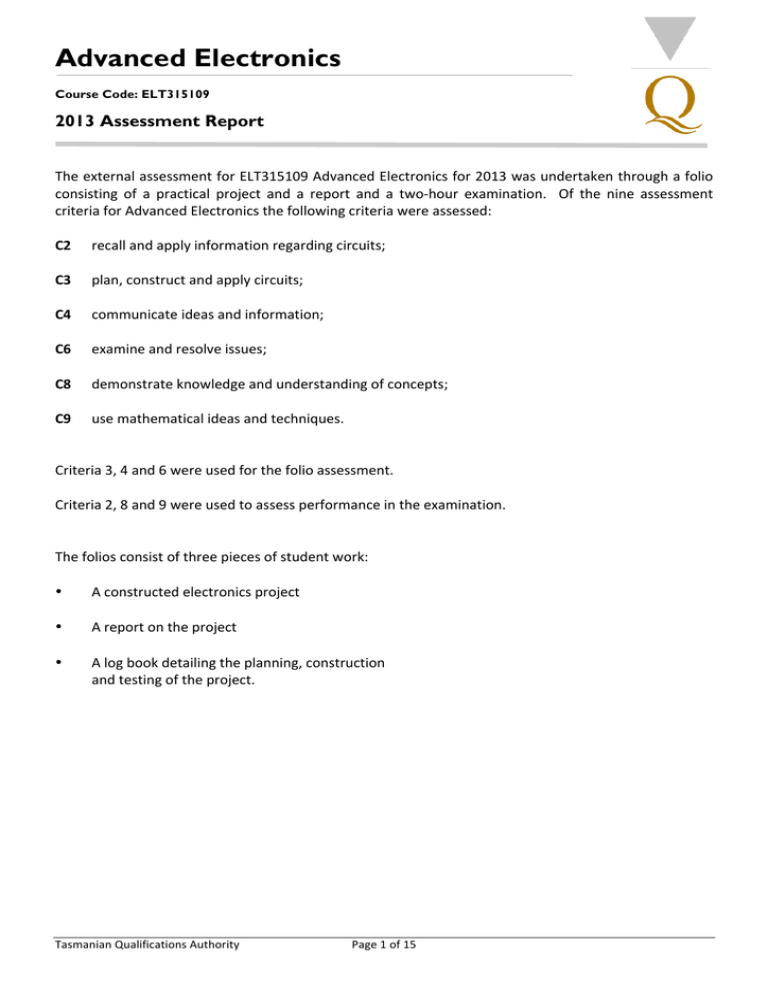ELT315109 - Advanced Electronics
advertisement

Advanced Electronics Course Code: ELT315109 2013 Assessment Report The external assessment for ELT315109 Advanced Electronics for 2013 was undertaken through a folio consisting of a practical project and a report and a two-­‐hour examination. Of the nine assessment criteria for Advanced Electronics the following criteria were assessed: C2 recall and apply information regarding circuits; C3 plan, construct and apply circuits; C4 communicate ideas and information; C6 examine and resolve issues; C8 demonstrate knowledge and understanding of concepts; C9 use mathematical ideas and techniques. Criteria 3, 4 and 6 were used for the folio assessment. Criteria 2, 8 and 9 were used to assess performance in the examination. The folios consist of three pieces of student work: • A constructed electronics project • A report on the project • A log book detailing the planning, construction and testing of the project. Tasmanian Qualifications Authority Page 1 of 15 2013 Assessment Report THE PROJECTS Candidates submitted a wide range of projects for assessments. Projects submitted: IR trip alarm Bass filter with boost (2) CNC remote control Voice disguiser (2) guitar practice amp Trip meter Digital thermometer Line following robot Lie detector Sound mixer Battery voltage monitor LED cube Car aux input and mixer Game module Soccer referee communications system Two stand sheep counter Ultrasonic sensor Reaction time tester Sound activated switch system Water level gauge (2) Remote controlled switch (2) Clap activated clock Valve amplifier preamp Door sentry Metronome FM radio transmitter VU Meter Light delay The markers were impressed by the high standard of design and construction shown in many of the projects. Most showed effective use of printed circuit board design software. The circuit boards were generally well made and in many cases were fitted into a suitable housing. All projects met the requirement for at least some original design by the candidate. PROJECT REPORTS Criterion 4 and Criterion 6 were used to assess the reports on the major projects. Almost all reports were well presented and produced using a word processor application. Schematic circuit diagrams were generally well presented and in many cases were accompanied by explanations in the text of the report. Many reports did incorporate function block diagrams in the description of the circuit. The use of function block diagrams is encouraged as they clearly illustrate the function and design concepts of the project. Most candidates used the design section to detail alternative circuits that could have been used to fulfil the required function. While most candidates included an evaluation of their project, more than usual only gave general overviews of the process. Where appropriate candidates should provide tables and graphs representing data collected during testing. This could include truth tables, logic and voltage level measurements, frequency analyses and graphical representation. Page 2 of 15 2013 Assessment Report LOG BOOKS The log book supported the assessment of Criterion 4 and Criterion 6. Most log books showed the work completed on the project during each classroom session. Many showed the work that was planned for the next session. Some log books were enhanced by the inclusion of diagrams of circuits being tested, test results and conclusions on how the results relate to the original problem being solved. THE EXAMINATION Markers comments and suggested solutions. Section A Question 1 Most students could deal with Bands 1 and 2 but had problems with Multiplier and Tolerance values. Capacitor coding was poorly applied by many students. a) b) 0.47 nF = 0.00047 mF, 155 decodes to 1500 nF, 333 decodes to 0.033 mF Question 2 Most students recalled potential dividers and parallel resistors well. a) V1= 15 V x 10k/(10k+22k)= 4.69 Volts b) V2 < V1 as 1 k in parallel lowers R hence lowers V2, V3>V1 as 1k in // lowers upper part of divider and increases Vout (V3). Question 3 Recall of capacitor OK. Recall of inductor was not so good. a) 12 V (maximum reached after 5 Tc) b) T=RC= 12000 x 16.7 mF =0.2 Page 3 of 15 2013 Assessment Report c) Charging curve lower and reaching 12 V after 2 seconds d) T= L/R = 0.5/2.5 = 0.2 s e) Curve decaying from 12 V to zero Question 4 Most students recalled the opamp features well. Many disregarded the specifications for opamp X in their answer to part b). a) Y is ideal due to higher input impedance and lower output impedance b) X will amplify 1 mV to 15000 mV but limited to 12 V (see specs) c) The difference between the two input voltages is amplified d) Stabilization of voltage gain Decreasing output impedance Increasing input impedance Decreasing distortion Increasing bandwidth Page 4 of 15 2013 Assessment Report Question 5 Most students recalled band pass filters and V~f graphing well. a) i) 100 mW ii) 3.53 V b) Question 6 Only a handful of students recalled the applications of opamp oscillators well. Graph labels were often omitted by students. a) 3 V b) c) Reduce R7 to 5 kΩ (or inc R8 to 20k) Page 5 of 15 2013 Assessment Report Question 7 Most students recalled the flip-­‐flop symbols and the synchronisation of flip-­‐flop inputs but many did not realise the falling edge has no effect on the flip-­‐flop output. Timing diagrams were only partially applied. a) On rising edges D=1 sets Q hi and D=0 resets Q low. On falling edges no change occurs. b) clock, negated i/o, falling edge of pulse c) D is synchronised with clock edge. S is asynchronously connected. e) d) connect ~Q to D Clock edge toggles Q. Section B Question 8 Most students understood this concept well. a) P=Z.X + Y.X b) When X is low computer Z is connected to the printer. When X is high the other computer is connected to the printer. AND gates are used to enable the printer control input. Most understood how the AND gates allow a computer to be selected but not all realised that only one could connect at a time due to the NOT gate. c) 1:Flexible operation, changes easily implemented in software 2: SSI means lower part requirements, reducing material and energy costs. Page 6 of 15 2013 Assessment Report Most gave two valid reasons, nearly every one gave one, some students just rephrased the same reason twice. Question 9 Many students understood this concept well. a) Answered well. 90% got it b) About 25% got full marks while others could give a correct value but without a valid reason. Some has problems with the intent of this question. c) Most created the resistor bridge correctly but marks were lost for incorrectly positioning the resistors. d) A third of students could identify the threshold value and drew a block shaped graph. Many students wrongly thought a curve was required. e) i) Half of students discussed the single threshold value and most of these identified this as the cause of the thrashing. ii) Very few students could draw the correct curve. iii) as above in ii) a) 200 ±50Ω b) Below 45 °C the heater must operate and a maximum current is required from the opamp to operate the mechanical relay. Vout will need to be saturated at 15V. c) d) Page 7 of 15 2013 Assessment Report e) i) In conditions below 45 °C the heater will operate raising the temperature to 45 °C then switch off. Very soon after, the sensor will cause the relay switch to operate the heater. This cycle will repeat, keeping the heater at 45°C. Eventually this rapid cycling will cause the relay to wear out. The heater will fail to operate due to mechanical failure of the relay contacts. ii) hysteresis graph. iii) A resistor, R4 is added to the output of the opamp feeding back to the divider input. R4 will apply a potential difference to the input causing hysteresis. Question 10 Some students understood this concept very well. a) i) About two thirds identified that active high was correct however very few could give a valid reason. ii) About a third of students gained at least one mark for identifying the charging process of the capacitor and its switch-­‐on-­‐reset function. Very few sketched the correct curve. b) Not answered well; about a third of students correctly identified its role in enabling the IC. c) Many recognised the RC combination as being for switch debounce but very few could give a detailed explanation. a) i) Page 8 of 15 2013 Assessment Report ii) b) c) Question 11 Many students understood this concept well. a) Answered well by most. b) Mostly answered well, many failed to provide an explanation c) Nearly a third gained partial marks, very few were able to identify all three keys words: quad, Schmitt and NAND. d) Part 1 Ok. Few students recognised IC1C’s function as an astable to control the buzzer. e) Stronger students recognised that carry out function in part i. Most students were able to answer part ii correctly. f) Correctly answered by half of students Page 9 of 15 2013 Assessment Report g) a) b) c) d) e) Many students understood that the displays were zeroed however most failed to notice that the 4024 counter is also reset. R1 and C1 form a switch-­‐debouncer sub-­‐circuit. When SW2 closes there may be multiple contacts resulting in an incorrect count (false triggering). R1 and C1 form a timer to hold the clock low for long enough to correct this problem. Common cathode type as common lead goes to ground. Also outputs from counter are high and these can go through the LED to ground. Quad 2 input NAND with Schmitt trigger inputs OR Quad 2-­‐input Schmitt trigger NAND is the description for IC1 i) An astable multivibrator (to operate the buzzer BZ) ii) An inverter (or inverting buffer) for the output from IC2. i) To carry out the tens from the ‘units’ counter to the ‘tens’ counter. ii) Positive power-­‐supply input. Pin 3 of IC3/IC4 goes high to enable display to illuminate. f) g) Display will illuminate show 00 while all counters are reset. Question 12 Most students understood this concept well. a) Very few correct answers. Many attempts failed to give a time. b) Most students gave an acceptable albeit general description of the role of the sensor c) More than half of the students were able to gain partial marks for outlining at least some of the control sequence. Stronger students gave the correct order and appreciated the timing of the latch resets. d) Answered quite well. Most students who attempted to give a solution suggested an AND gate instead of an OR. e) Nearly half of students attempted this. Most were able to identify a least two block elements making use of the temp sensor and fan control. Many missed the 5 s delay. a) Two seconds. Page 10 of 15 2013 Assessment Report b) c) When heating the temperature sensor’s output is high. This keeps the gas valve in the open state. d) e) Section C Question 13 Most students succeeded with binary and BCD conversions. Many struggled with the hexadecimal conversion. a) i) 2C16 ii) 4410 b) 0111 1000 0101BCD Page 11 of 15 2013 Assessment Report Question 14 Not well answered. Many used an incorrect formula. a) b) Question 15 Most students selected the appropriate formulas and then substituted the correct values. a) 1.5 V b) P=IV = 0.15 W c) i) R=(Vs-­‐VLED)/I = 165 Ω ∴ use 180R. ii) Page 12 of 15 2013 Assessment Report Question 16 Formula selection and calculation were done well in parts a and b. Nearly half found part c challenging with the cut-­‐off frequencies phase the main difficulty. a) b) c) Question 17 Part a of this question was well answered but many students found transposing the formula for part b challenging. Part c was not done well. a) Page 13 of 15 2013 Assessment Report b) c) Question 18 Most candidates did not recognise the significance of a negative voltage. This error was carried over to the remaining parts of the question. Parts b (ii) and b (iii) omitted by many candidates. a) b) c) Page 14 of 15 2013 Assessment Report Question 19 Many students did not accurately interpret the information given in the graph and this affected the remaining parts of the question. Two thirds of the students failed to select the correct formula for the question in part d. a) T = 3.6 div x 0.1 ms/div = 0.36 ms b) f = T-­‐1 = 0.36-­‐1 = 2700 Hz c) d) The marking scheme given on the paper was applied as follows; Criterion/Rating A B C 2 31 -­‐ 40 19 -­‐ 30 14 -­‐ 18 8 26 -­‐ 40 22 -­‐ 25 12 -­‐ 21 9 28 -­‐ 40 20 -­‐ 27 14 -­‐ 19 Page 15 of 15 D 1 -­‐ 13 1 -­‐ 11 1 -­‐ 13 TASMANIAN QUALIFICATIONS AUTHORITY ELT315109 Advanced Electronics ASSESSMENT PANEL REPORT Award Distribution EA HA CA SA This year 8% (2) 27% (7) 12% (3) 54% (14) 26 Last year 8% (2) 29% (7) 33% (8) 29% (7) 24 Last year (all examined subjects) 11 % 19 % 39 % 31 % Previous 5 years 18 % 16 % 19 % 47 % Previous 5 years (all examined subjects) 11 % 19 % 39 % 30 % Female Year 11 Year 12 Student Distribution (SA or better) Male This year 92% (24) 8% (2) 12% (3) 88% (23) Last year 100% (24) 0% (0) 42% (10) 58% (14) 96% 4% 26% 74% Previous 5 years Total



